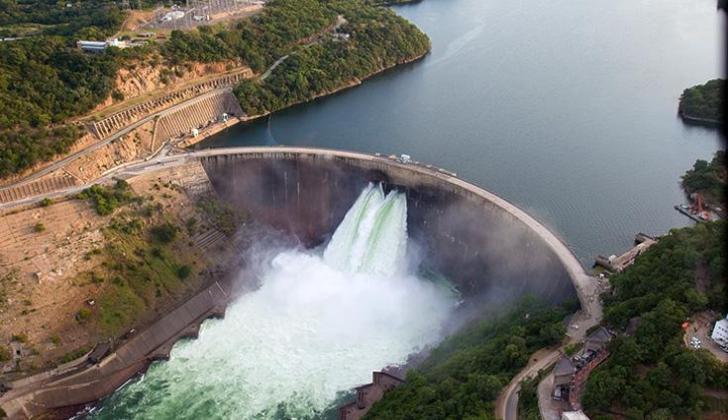News / National
Zimbabwe's power supplies improve on Kariba water boost
30 Mar 2025 at 14:34hrs |
14 Views

Zimbabwe's power generation and supply have significantly improved, driven by increased water allocation from the Zambezi River Authority (ZRA) and enhanced output from the Hwange Power Station. This positive development is expected to support winter wheat production and bolster the country's broader economic outlook.
ZRA, which manages the Kariba Dam on behalf of Zimbabwe and Zambia, has increased water allocations following a rise in water levels due to normal to above-normal rainfall during the 2024/2025 rainy season. Consequently, power generation at Kariba has surged from 185 megawatts (MW) to 485MW.
By the end of last week, Zimbabwe's total power output exceeded 1 500MW, reaching a peak of 1 622MW on Friday. Energy and Power Development Minister July Moyo confirmed that further improvements are expected in the coming months. "We received an increase in water allocation for both Zimbabwe and Zambia. This has significantly enhanced our power generation," he said.
The ZRA recently increased water allocation for power generation to 27 billion cubic metres this year, up from 16 billion cubic metres in the previous year. Additionally, Unit 7 at Hwange, currently undergoing maintenance, is expected to return to service soon, further boosting capacity.
Independent power producers (IPPs) are also expected to contribute to the grid. Starting in April, Chiredzi Green Fuel and other IPPs, which currently supply 71MW, will add more capacity. Zimbabwe has faced power shortages in recent years due to droughts linked to El Niño and the refurbishment of aging units at Hwange. However, the commissioning of two new units, 7 and 8, has significantly improved generation capacity.
The Zimbabwe Power Company (ZPC) is refurbishing six additional units at Hwange with funding from the Export-Import Bank of India. This initiative aligns with the government's broader strategy to boost local power generation, reduce reliance on electricity imports, and minimize load shedding, thereby supporting industrial production.
Zimbabwe Electricity Supply Authority (Zesa) executive chairperson Dr. Sydney Gata recently stated that the company aims to achieve electricity self-sufficiency by 2028. As part of this target, Zesa plans to commission at least six new power plants this year, expected to add a combined 1 000MW to the national grid. The long-term goal is to generate 2 690MW by 2029.
Finance, Economic Development, and Investment Promotion Minister Professor Mthuli Ncube has emphasized the link between increased agricultural production, improved power supply, and economic growth. In the 2025 National Budget, he projected a 6 percent economic growth rate, largely supported by these key sectors.
With sustained improvements in power generation, Zimbabwe is set to strengthen its industrial base, support agricultural productivity, and enhance overall economic stability.
ZRA, which manages the Kariba Dam on behalf of Zimbabwe and Zambia, has increased water allocations following a rise in water levels due to normal to above-normal rainfall during the 2024/2025 rainy season. Consequently, power generation at Kariba has surged from 185 megawatts (MW) to 485MW.
By the end of last week, Zimbabwe's total power output exceeded 1 500MW, reaching a peak of 1 622MW on Friday. Energy and Power Development Minister July Moyo confirmed that further improvements are expected in the coming months. "We received an increase in water allocation for both Zimbabwe and Zambia. This has significantly enhanced our power generation," he said.
The ZRA recently increased water allocation for power generation to 27 billion cubic metres this year, up from 16 billion cubic metres in the previous year. Additionally, Unit 7 at Hwange, currently undergoing maintenance, is expected to return to service soon, further boosting capacity.
Independent power producers (IPPs) are also expected to contribute to the grid. Starting in April, Chiredzi Green Fuel and other IPPs, which currently supply 71MW, will add more capacity. Zimbabwe has faced power shortages in recent years due to droughts linked to El Niño and the refurbishment of aging units at Hwange. However, the commissioning of two new units, 7 and 8, has significantly improved generation capacity.
The Zimbabwe Power Company (ZPC) is refurbishing six additional units at Hwange with funding from the Export-Import Bank of India. This initiative aligns with the government's broader strategy to boost local power generation, reduce reliance on electricity imports, and minimize load shedding, thereby supporting industrial production.
Zimbabwe Electricity Supply Authority (Zesa) executive chairperson Dr. Sydney Gata recently stated that the company aims to achieve electricity self-sufficiency by 2028. As part of this target, Zesa plans to commission at least six new power plants this year, expected to add a combined 1 000MW to the national grid. The long-term goal is to generate 2 690MW by 2029.
Finance, Economic Development, and Investment Promotion Minister Professor Mthuli Ncube has emphasized the link between increased agricultural production, improved power supply, and economic growth. In the 2025 National Budget, he projected a 6 percent economic growth rate, largely supported by these key sectors.
With sustained improvements in power generation, Zimbabwe is set to strengthen its industrial base, support agricultural productivity, and enhance overall economic stability.
Source - The Sunday Mail
Join the discussion
Loading comments…































